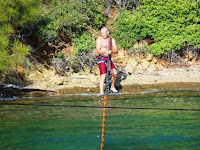 |
| Marmaris Castle built 1044BC |
Despite the
plan to sail from Marmaris to Goeck we were thwarted by lack of wind and ended
up sailing around Marmaris bay and anchored outside Yacht Marina where we
started from. Marmaris Bay is the centre of Turkish yachting and charter
industry and a beach holiday destination. The large bay is picturesque and is
surrounded by pine forests and hotels with numerous anchorages. The town of
Marmaris was devastated by an earthquake in 1958 so not many old buildings remain
the exception being the medieval fortress built on a rocky knoll. The only
positive of returning to the same place was a kiwi yacht was already anchored
there which resulted in an enjoyable evening of drinks onboard Birgitta.
 |
| Daily exercise taking lines ashore |
The next day
the wind arrived and we had a great day’s sailing, in prefect conditions
reaching in 15kts to Gocek 45NM. On arrival, we planned to anchor in 22 Fathom
Bay (a deep by on the W coast of the bay). However, this planned was thwarted
by our inability to set the anchor in 15-20mtrs of water. Despite two different
locations and the anchor being reset six times it would not hold in the weedy /
muddy bottom. By this time the windlass (anchor) switch had overheated and
failed - along with our sense of humour. With only one hour of light left we
motored off in frustration to a Goeck marina for the night. Goeck has five
marina’s which appears to be the major industry with a lovely village to stroll
in. The next morning we were relieved to have the windlass switch operating and
headed out to find a bay to anchor in.
 |
| Friendly local visit |
 |
| Finally on the mooring |
As we were
motoring past Adasi Island Leanne spied some mooring boys so we quickly diverted
to pick one up. This became another trial and learning point - after picking up
the the first bouy we realised by the time Sabbaticus swung around we were too
close to shore. The next bouy we picked up was then too close to some rocks.
We rounded the next point and picked up another bouy - having secured one line
ashore the second line was too short. Arghh! Our sense of humour was starting to
fail again - the fourth bouy was perfect. After all this effort we stayed fora
couple of nights to rest and relax with lots of swims to cool off in the
inevitable midday/afternoon heat. The bay is beautiful with pine covered slopes
to the water edge, deep clear water, and large turtles swimming in close
proximity to the boat. Every day we had new 'neighbours' arrive, usually tourist gulets stopping for an hour to swim before the next boat arrived so there was plenty of anchoring skills.
 |
| Memorial to Fethie Bay |
It was then a
short trip, 12NM, across to Fethiye located in another picturesque bay with pine
trees around the natural harbour. We anchored in the bay outside the marinas - all the better to get the cooling breeze. Although Fethiye was flattened in the same
earthquake as Marmaris the ancient theatre, medieval fort and Lycian rock tombs
survived. The largest tomb is the Tomb of Amyntas, dating back to 4th century
BC. We learned that Fethiye is named after a local Air Force aviator who died
while attempting to fly between Istanbul and Cairo in 1914.
 |
| Men's coffee group? |
Wile we would have liked to head further south, there was no wind
forecast and motoring for 8 hours was not appealing. So instead we had a
relaxing few days at anchor with daily trips into Fethiye town where Leanne
enjoyed the markets and John the wifi cafés. As always the local cafes had the men sitting around drinking coffee while board games - a familiar sight in Turkey and Greece. Rarely are groups of women seen sitting around - guess they are all at home working.
During the time in Fethiye Sabbaticus was re-provisioned, spares re-packed, laundry taken ashore for a 'real wash' as opposed to buckets on the foredeck and another boat wash completed in preparation for our passage to Sicily. Friends from the UK, Sally and Bata, are joining us for the trip to Sicily which will be good to have the company onboard and longer sleeps during each watch change which will be luxury. After doing day sails for the last few months we are keen to get going and sail a longer passage - this will be the last passage for this season before Sabbaticus hibernate's in a marina in Sicily for winter.
 |
| Lycian Rock Tombs - 4th century BC |
 |
| Marmaris monument to Ataturk - Turkey's first President |






















